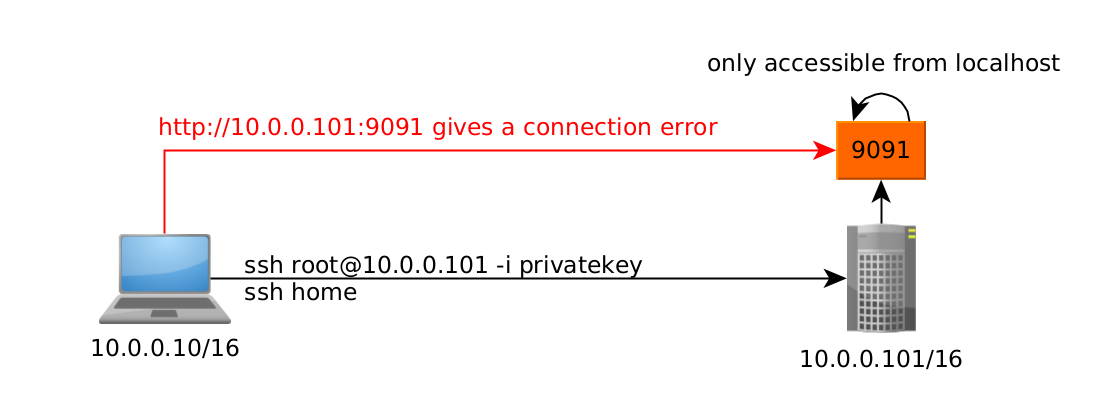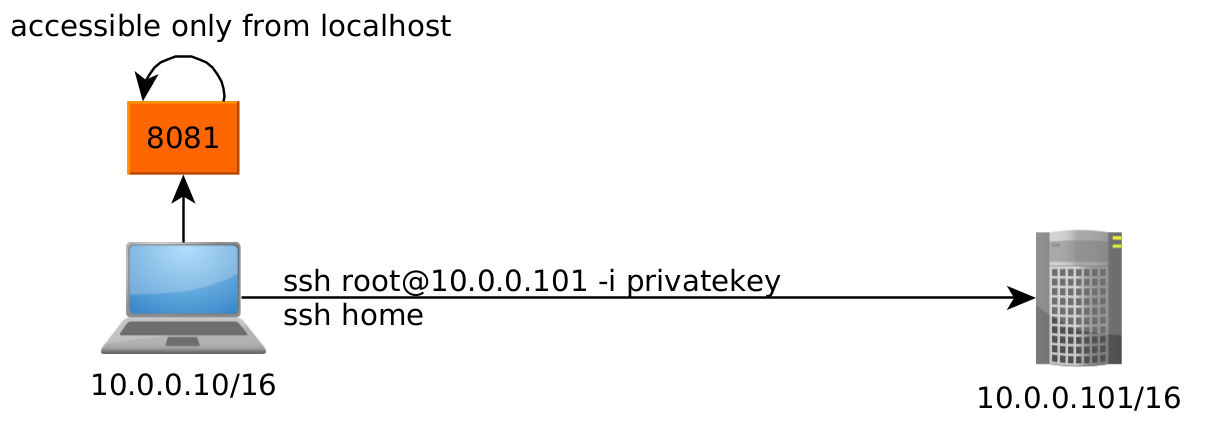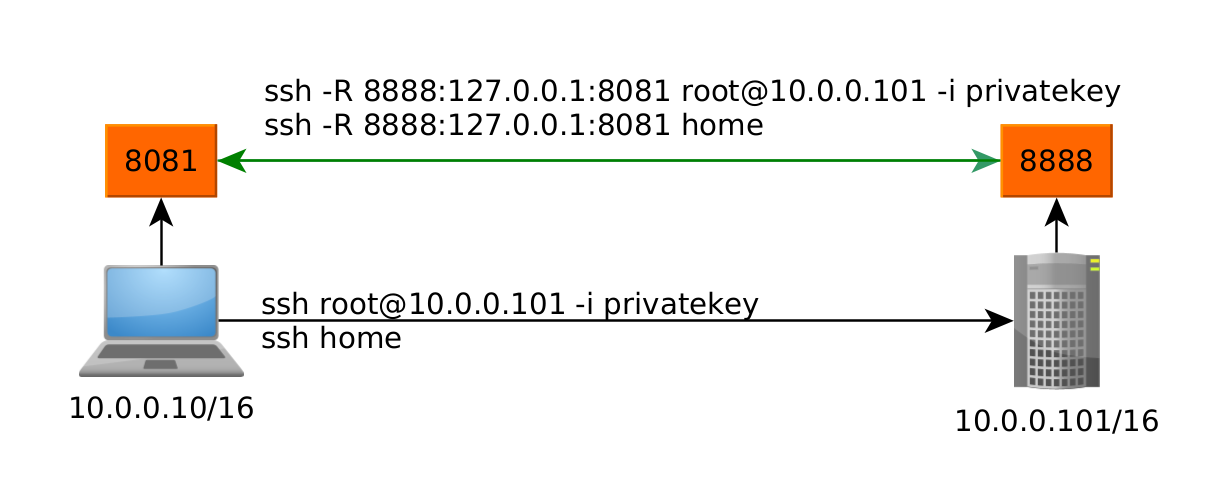
SSH Tunnels

Introduction :
SSH tunnels are commonly used in sysadmin and pentesting tasks in order to access remotel-only or local-only accessible ports. In this tutorial we're going to demonstrate how it works:


SSH tunnels are commonly used in sysadmin and pentesting tasks in order to access remotel-only or local-only accessible ports. In this tutorial we're going to demonstrate how it works:
The prerequisite is obvious, get a SSH connection, i will use my ssh connection to my home host:
[ 10.66.66.2/32 ] [ /dev/pts/19 ] [blog/HTB/Tools]
→ cat ~/.ssh/config
Host home
Hostname 10.0.0.101
IdentityFile ~/.ssh/mainpc
User root
[ 10.66.66.2/32 ] [ /dev/pts/18 ] [blog/HTB/Tools]
→ ssh home
Linux home 4.19.0-16-amd64 #1 SMP Debian 4.19.181-1 (2021-03-19) x86_64
The programs included with the Debian GNU/Linux system are free software;
the exact distribution terms for each program are described in the
individual files in /usr/share/doc/*/copyright.
Debian GNU/Linux comes with ABSOLUTELY NO WARRANTY, to the extent
permitted by applicable law.
Last login: Tue Jun 15 09:03:34 2021 from 10.0.0.10
root@home:~#
That's a SSH connection using the private key in my ~/.ssh/ directory. Of course this also works with regular SSH connections, you just have to specify the username and the remote host ssh user@ip
[ 10.66.66.2/32 ] [ /dev/pts/18 ] [blog/HTB/Tools]
→ ssh root@10.0.0.101
root@10.0.0.101's password:
Linux home 4.19.0-16-amd64 #1 SMP Debian 4.19.181-1 (2021-03-19) x86_64
The programs included with the Debian GNU/Linux system are free software;
the exact distribution terms for each program are described in the
individual files in /usr/share/doc/*/copyright.
Debian GNU/Linux comes with ABSOLUTELY NO WARRANTY, to the extent
permitted by applicable law.
Last login: Tue Jun 15 10:57:36 2021 from 10.0.0.10
root@home:~#
Currently i am using the following network :

One of the many use cases you want to use SSH tunnels for, is to access ports that are only remotely accessible. For example, there is a port that will only accept connections from localhost (127.0.0.1), In theory this is not possible to access this port from across the network, it should only be possible on the server ITSELF.

Now the use case of SSH tunnels here is that we want to be able to access that 9091 port on the 10.0.0.101 host locally. But we currently can't because it restrics connections from it's localhost.
[terminal 1]
root@home:/tmp/test# python3 -m http.server 9091 --bind 127.0.0.1
Serving HTTP on 127.0.0.1 port 9091 (http://127.0.0.1:9091/) ...
[terminal 2]
[ 10.66.66.2/32 ] [ /dev/pts/18 ] [blog/HTB/Tools]
→ curl 10.0.0.101:9091
curl: (7) Failed to connect to 10.0.0.101 port 9091: Connection refused
[ 10.66.66.2/32 ] [ /dev/pts/18 ] [blog/HTB/Tools]
→ ssh home
root@home:~# curl 127.0.0.1:9091
Directory listing for /
Now here you see that we can only access the webserver from the hosts' localhost. So let's spawn a SSH Tunnel to port forward the remote 9091 port to our local port with the -L flag with the following syntax:
ssh -L [local_bind:]localport:remote_bind:remoteport user@ip
If we don't specify the local bind, ssh assumes that this is 127.0.0.1, so let's say we want to port forward the remote port 9091 to our local port 9999 we use the following command:
[ 10.66.66.2/32 ] [ /dev/pts/18 ] [blog/HTB/Tools]
→ ssh -L 9999:127.0.0.1:9091 home
Linux home 4.19.0-16-amd64 #1 SMP Debian 4.19.181-1 (2021-03-19) x86_64
The programs included with the Debian GNU/Linux system are free software;
the exact distribution terms for each program are described in the
individual files in /usr/share/doc/*/copyright.
Debian GNU/Linux comes with ABSOLUTELY NO WARRANTY, to the extent
permitted by applicable law.
Last login: Tue Jun 15 12:22:58 2021 from 10.0.0.10
root@home:~#

Now with this the SSH Tunnel is active, and you can verify that we port forwarded the remote port 9091 to our local port 9999 :
[ 10.66.66.2/32 ] [ /dev/pts/19 ] [blog/HTB/Tools]
→ curl 127.0.0.1:9999
Directory listing for /
Now we can also do the opposite, where we expose one of our local ports to the remote server using the -R flag which stands for Reverse:
[ 10.66.66.2/32 ] [ /dev/pts/0 ] [/tmp/test]
→ python3 -m http.server 8081 --bind 127.0.0.1
Serving HTTP on 127.0.0.1 port 8081 (http://127.0.0.1:8081/) ...

We can check it is there with curl:
[ 10.66.66.2/32 ] [ /dev/pts/19 ] [blog/HTB/Tools]
→ curl 127.0.0.1:8081
Directory listing for /
[ 10.66.66.2/32 ] [ /dev/pts/19 ] [blog/HTB/Tools]
→ ssh home
root@home:~# curl 10.0.0.10:8081
curl: (7) Failed to connect to 10.0.0.10 port 8081: Connection refused
So we create a SSH tunnel using the following syntax:
ssh -R [remote_bind:]remoteport:localbind:localport user@ip
Same as before, the remote bind isn't needed, by default it will use localhost.

Here we want the remote host to have our local 8081 port to be forwarded to the remote 8888 port:
[ 10.66.66.2/32 ] [ /dev/pts/18 ] [/tmp/test]
→ ssh -R 8888:127.0.0.1:8081 home
root@home:~# curl 127.0.0.1:8888
Directory listing for /
And that's it! We verified that our port forwarding was successful.
Donate XMR: 8AUYjhQeG3D5aodJDtqG499N5jXXM71gYKD8LgSsFB9BUV1o7muLv3DXHoydRTK4SZaaUBq4EAUqpZHLrX2VZLH71Jrd9k8